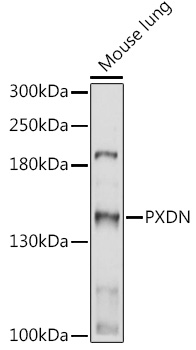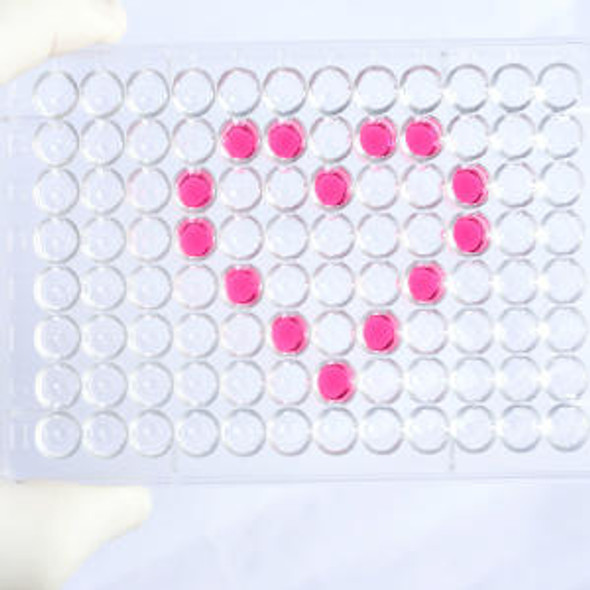Cell Biology Antibodies 15
Anti-PXDN Antibody (CAB17929)
- SKU:
- CAB17929
- Product Type:
- Antibody
- Reactivity:
- Human
- Reactivity:
- Mouse
- Host Species:
- Rabbit
- Isotype:
- IgG
- Antibody Type:
- Polyclonal Antibody
- Research Area:
- Cell Biology
Description
| Antibody Name: | Anti-PXDN Antibody |
| Antibody SKU: | CAB17929 |
| Antibody Size: | 20uL, 50uL, 100uL |
| Application: | WB |
| Reactivity: | Human, Mouse |
| Host Species: | Rabbit |
| Immunogen: | Recombinant protein of human PXDN. |
| Application: | WB |
| Recommended Dilution: | WB 1:500 - 1:2000 |
| Reactivity: | Human, Mouse |
| Positive Samples: | Raji, Mouse lung |
| Immunogen: | Recombinant protein of human PXDN. |
| Purification Method: | Affinity purification |
| Storage Buffer: | Store at -20°C. Avoid freeze / thaw cycles. Buffer: PBS with 0.02% sodium azide, 50% glycerol, pH7.3. |
| Isotype: | IgG |
| Sequence: | Email for sequence |
| Gene ID: | 7837 |
| Uniprot: | Q92626 |
| Cellular Location: | |
| Calculated MW: | |
| Observed MW: | 165KDa |
| Synonyms: | PXN, VPO, MG50, PRG2, ASGD7, COPOA, D2S448, D2S448E, PXDN |
| Background: | This gene encodes a heme-containing peroxidase that is secreted into the extracellular matrix. It is involved in extracellular matrix formation, and may function in the physiological and pathological fibrogenic response in fibrotic kidney. Mutations in this gene cause corneal opacification and other ocular anomalies, and also microphthalmia and anterior segment dysgenesis. |
| UniProt Protein Function: | PXDN: Displays low peroxidase activity and is likely to participate in H(2)O(2) metabolism and peroxidative reactions in the cardiovascular system. Plays a role in extracellular matrix formation. Belongs to the peroxidase family. XPO subfamily. 2 isoforms of the human protein are produced by alternative splicing. |
| UniProt Protein Details: | Protein type:EC 1.11.1.7; Oxidoreductase; Secreted; Secreted, signal peptide Chromosomal Location of Human Ortholog: 2p25.3 Cellular Component: endoplasmic reticulum; extracellular matrix; extracellular region; extracellular space; proteinaceous extracellular matrix Molecular Function:extracellular matrix structural constituent; heme binding; interleukin-1 receptor antagonist activity; metal ion binding; peroxidase activity Biological Process: extracellular matrix organization; hydrogen peroxide catabolic process; immune response; negative regulation of cytokine and chemokine mediated signaling pathway; response to oxidative stress Disease: Corneal Opacification With Other Ocular Anomalies |
| NCBI Summary: | This gene encodes a heme-containing peroxidase that is secreted into the extracellular matrix. It is involved in extracellular matrix formation, and may function in the physiological and pathological fibrogenic response in fibrotic kidney. Mutations in this gene cause corneal opacification and other ocular anomalies, and also microphthalmia and anterior segment dysgenesis. [provided by RefSeq, Aug 2014] |
| UniProt Code: | Q92626 |
| NCBI GenInfo Identifier: | 109150416 |
| NCBI Gene ID: | 7837 |
| NCBI Accession: | NP_036425.1 |
| UniProt Secondary Accession: | Q92626,Q4KMG2, A8QM65, D6W4Y0, |
| UniProt Related Accession: | Q92626 |
| Molecular Weight: | |
| NCBI Full Name: | peroxidasin homolog |
| NCBI Synonym Full Names: | peroxidasin |
| NCBI Official Symbol: | PXDN |
| NCBI Official Synonym Symbols: | PXN; VPO; MG50; PRG2; ASGD7; COPOA; D2S448; D2S448E |
| NCBI Protein Information: | peroxidasin homolog |
| UniProt Protein Name: | Peroxidasin homolog |
| UniProt Synonym Protein Names: | Melanoma-associated antigen MG50; Vascular peroxidase 1; p53-responsive gene 2 protein |
| UniProt Gene Name: | PXDN |







